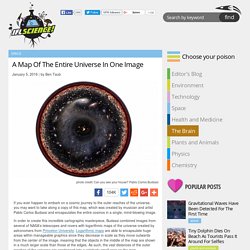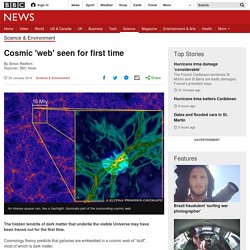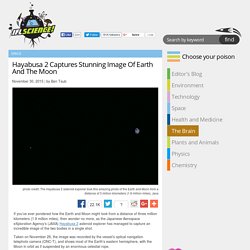

Le télescope spatial japonais Hitomi en perdition un mois après son lancement. Ce mastodonte à un demi-milliard d'euros environ aurait perdu plusieurs morceaux pour une raison encore inconnue.

Les ingénieurs de la JAXA tentent de reprendre le contrôle du satellite. Que s'est-il passé? Un mois seulement après son lancement réussi le 17 février dernier, l'agence spatiale japonaise (JAXA) a perdu samedi le contact avec son télescope spatial Astro-H, rebaptisé Hitomi (pupille en japonais) après son lancement, comme le veut la tradition. L'orbite du gigantesque insecte métallique de 2,7 tonnes et 14 mètres de long a été modifiée de 5 km (il se situe à moins de 600 km d'altitude). D'après les observations effectuées depuis le sol, cinq débris l'accompagnent désormais dans sa course. Deux scénarios sont possibles.
La JAXA essaye depuis ce week-end de reprendre le contrôle de son satellite. Si les choses en restaient là, le gâchis serait immense. Calendrier julien, multiples de 400, mécanique céleste : pourquoi y a-t-il un 29 février ? Le Monde.fr | • Mis à jour le | Par Gary Dagorn Les années bissextiles sont le moyen le plus simple qu’ont trouvé les Romains pour coordonner imparfaitement le calendrier sur la durée de l’année solaire, c’est-à-dire sur l’intervalle de temps pour que le Soleil, vu de la Terre, retourne à la même position en suivant le rythme des saisons (par exemple entre deux équinoxes de printemps ou entre deux solstices d’été).

Une année solaire dure environ 365,25 jours. Pour compenser cette différence, on intercale un jour après le 28 février tous les quatre ans. L’année bissextile, introduite par Jules César en 46 avant J. Visible Light From A Black Hole Spotted For The First Time Ever. In a cosmic first, astronomers have spotted visible light coming from a black hole during a violent outburst of energy.

The discovery, made from observations of a nearby black hole binary called V404 Cygni, suggests other black holes could be studied in this way – with nothing more than a backyard telescope. This research was led by astronomers from Kyoto University, published in Nature, and presented at the American Astronomical Society meeting in Florida this week. On June 15, 2015, the black hole "woke up" after 26 years of being dormant, emitting an outburst of energy. Usually, astronomers observe these events in other wavelengths such as X-rays or gamma-rays. A Map Of The Entire Universe In One Image. If you ever happen to embark on a cosmic journey to the outer reaches of the universe, you may want to take along a copy of this map, which was created by musician and artist Pablo Carlos Budassi and encapsulates the entire cosmos in a single, mind-blowing image.

In order to create this incredible cartographic masterpiece, Budassi combined images from several of NASA’s telescopes and rovers with logarithmic maps of the universe created by astronomers from Princeton University. Logarithmic maps are able to encapsulate huge areas within manageable graphics since they decrease in scale as they move outwards from the center of the image, meaning that the objects in the middle of the map are shown in a much larger scale than those at the edges.
Cosmic 'web' seen for first time. Image copyright A.

Klypin/J. Primack/S. Cantalupo The hidden tendrils of dark matter that underlie the visible Universe may have been traced out for the first time. Cosmology theory predicts that galaxies are embedded in a cosmic web of "stuff", most of which is dark matter. The Universe's "Missing Matter" Found Within Superheated Cosmic Web Filaments.
Everything you can see around you is composed of “ordinary matter.”

Looking at the remnant radiation of the Big Bang, the cosmic microwave background (CMB), scientists have calculated that this matter consists of only five percent of the entire universe. Hayabusa 2 Captures Stunning Image Of Earth And The Moon. If you’ve ever pondered how the Earth and Moon might look from a distance of three million kilometers (1.9 million miles), then wonder no more, as the Japanese Aerospace eXploration Agency’s (JAXA) Hayabusa 2 asteroid explorer has managed to capture an incredible image of the two bodies in a single shot.

Taken on November 26, the image was recorded by the vessel’s optical navigation telephoto camera (ONC-T), and shows most of the Earth’s eastern hemisphere, with the Moon in orbit as if suspended by an enormous celestial rope. Scientist Claims He Has Found Evidence Of Other Universes. A new study submitted to the Astrophysical Journal has claimed to have found evidence of interactions between our universe and other universes by looking at the cosmic microwave background (CMB).

The scientist discovered an anomaly associated with some regions of the CMB, and he believes it is evidence for alternate universes. Dr Ranga Chary, the author of the study, wrote that his observations could "possibly be due to the collision of our universe with an alternate universe whose baryon to photon ratio is a factor of about 65 larger than ours. " NASA Releases Stunning Half-Hour Ultra HD Video Of The Sun. NASA has created its first few ultra-high definition videos, and the results are truly spectacular.

Among the items released is a jaw-dropping 30-minute portrait of the Sun, which was put together from data captured by the Solar Dynamics Observatory (SDO). Launched in early 2010, the SDO observes the Sun around the clock, capturing images in ten different wavelengths, each of which highlights a different temperature of solar material. Rare Double Star System Seen In Final Death Throes Before It Explodes. An incredible stellar system has been found where two stars are so close that their surfaces are overlapping.

It is the hottest and most massive double star system ever seen, and provides a rare glimpse into what is believed to be a relatively brief cosmic event. The system is known as VFTS 352, found 160,000 light-years away in the Tarantula Nebula by the European South Observatory's Very Large Telescope. What Is The Biggest Star In The Universe? The universe is a big place, and it is home to a lot of big objects. For humans, contemplating even the size of Earth can be a struggle. It can be even more uncomfortable to consider that the planet under our feet is barely a speck when compared to the star it rolls its constant path around: the Sun. What Is The Biggest Star In The Universe? Project Apollo Archive’s albums.
Ces incroyables photos de la NASA prises sur la Lune. Here's What Would Happen To Your Brain If You Took A Trip To Mars. How Accurate Is The Martian? 9 Things The Movie Got Right And Wrong. "The Martian" is hitting cinemas right about now, and already it is being heralded as one of the most scientifically accurate sci-fi films of all time. We’ve seen the movie, and we’ve got to say, it’s amazing how far we’ve come since "Armageddon" (shudder). NASA has been so impressed, they've been using the movie as a marketing campaign for their own, actual manned missions to Mars in the 2030s. Based on the book of the same name by Andy Weir, itself praised for its accuracy, director Ridley Scott asked NASA to check the film and ensure everything in it was correct – or as correct as can be.
But just how did they do? Here we pick through the science in the movie, with the help of a few experts, to see if "The Martian" is deserving of its accolades. Be warned, though, there are some spoilers in this post. Check Out These Spectacular New Images Of Pluto. NASA just released their new images of Pluto and they are stunning. The header image above features Pluto’s crescent and was captured on July 14th by New Horizons Ralph/Multispectral Visual Imaging (MVIC) camera and downlinked on September 13. In it we see the incredible Plutonian landscape backlit by the Sun. “This image really makes you feel you are there, at Pluto, surveying the landscape for yourself,” said New Horizons Principal Investigator Alan Stern, in a statement. “But this image is also a scientific bonanza, revealing new details about Pluto’s atmosphere, mountains, glaciers and plains.”
Scientists Detect The Oldest, Most Distant Galaxy Known So Far. After spending years searching the cosmos, a research team from CalTech may have found the oldest and most distant galaxy yet. As part of its search, the team combed through data collected by the Hubble Space Telescope and the Spitzer Space telescope, and ultimately identified the galaxy EGS8p7 as a target to investigate further. The team then performed a spectrographic analysis of EGS8p7 using the Keck Observatory’s multi-object spectrometer for infrared exploration (MOSFIRE) to calculate its redshift. Redshift is a result of the Doppler effect – like when an ambulance drives by and the siren fades as it passes. In astronomy, instead of sound waves, light from the galaxy is stretched and shifted towards the red end of the spectrum as it moves farther away.
Based on the data collected, the team estimates that EGS8p7 is over 13.2 billion years old, meaning it was formed only around 600 million years after the Big Bang. A Brief History Of Everything, With Neil deGrasse Tyson. Kepler-452b: Earth's Bigger, Older Cousin. NASA will host a news teleconference at noon EDT Thursday, July 23 to announce new discoveries made by its planet-hunting mission, the Kepler Space Telescope.
The first exoplanet orbiting another star like our sun was discovered in 1995. Exoplanets, especially small Earth-size worlds, belonged within the realm of science fiction just 21 years ago. First Close-Up Photograph Of Pluto's Surface Released. Just 24 hours after receiving confirmation that the New Horizons spacecraft survived its encounter with the Pluto system, NASA released the first close-up view of Pluto’s surface. The high-resolution image is just one segment of a larger mosaic of the lower left portion of Pluto’s “heart.” The region – now officially dubbed Tombaugh Regio after the man who discovered the icy world – features a mountain range similar to the Rocky Mountains with peaks towering as high as 3,500 meters (11,000 feet) above the surface and composed of water ice.
The mountains are young and thought to have formed no more than 100 million years ago – which makes them very young when compared to the age of the Solar System. New Super-Hubble Telescope Could Find out if we are Alone in the Universe. When it comes to astronomy, bigger is almost always better. Although the iconic Hubble Space Telescope is set to be eclipsed by a telescope three times its size in 2018, the James Webb Space Telescope (JWST), astronomers have already proposed an even more impressive space observatory that would put both of them to shame. Hubble Detects Massive Gas Halo Surrounding Andromeda Galaxy.
Missing 'Galactic Dinosaurs' Found Hiding In Plain Sight. It’s long been presumed that millions of ancient compact spherical galaxies, abundant in the early universe about 11 billion years ago but scarce now, collided and formed much larger clouds of stars with little form. But a new study, published in The Astrophysical Journal, suggests that these “galactic dinosaurs” didn’t go extinct after all, and have actually been hiding in plain sight this whole time. When looking at the early universe, astronomers in 2005 found that there was an overabundance of smaller, more compact spherical galaxies, which was at odds with what they see today as the universe is now filled with large “elliptical” galaxies and spiral galaxies such as our Milky Way. Missing 'Galactic Dinosaurs' Found Hiding In Plain Sight.
The sun is now virtually blank during the weakest solar cycle in more than a century « Vencore Weather. 30Apr/15Thu. Breathtaking 3D Model Of The Pillars Of Creation. Hubble Offered A Rare, Ring-Side Seat At The Death Of A Star. Could Tau Ceti Be Humanity's Next Home? Scientists at Arizona State University have combined astronomy and geophysics to assess the possibility of other planets being able to support life.
After turning their attention towards Tau Ceti, a star system popular with science fiction writers due to its similarities to our own sun, they have concluded that it is probably not going to be mankind’s next home. NASA : La sonde New Horizons débute son exploration de Pluton et envoie des images en couleur. La sonde New Horizons a commencé à explorer Pluton après plus de neuf ans de voyage et 4,8 milliards de kilomètres parcourus. C’est vers le 14 juillet que la sonde de la NASA sera au plus proche de cette planète naine plus petite que la Lune.
Espace: En ratant son atterrissage, Philae a fait faire un bond à la science. Afin d'être publiée, votre note : La naissance de la Lune serait bien due à une collision entre la Terre et sa sœur jumelle Théia. Astronomers Track Birth Of A Giant. Large Hadron Collider Could Detect Extra Dimensions. VIDEO. La sonde Dawn a un rendez-vous historique avec la planète naine Cérès. Travel Through The Solar System At The Speed Of Light. Researchers Claim To Have Found Evidence of Dark Matter In Inner Milky Way. Beagle-2 lander found on Mars / Mars Express. Planetary Alignment On Jan 4, 2015 Will Decrease Gravity For 5 Minutes Causing Partial Weightlessness. Sky Watching Event Guide For 2015. The Next 209 Seconds Will Blow Your Mind. Internet aux autres 3 milliards : la constellation de satellites au complet. This Is What Astronauts See As They Re-Enter Earth's Atmosphere. Is There a Parallel Universe That's Moving Backwards in Time? Every Ship That Has Carried Humans Into Space Scaled Into One Chart.
"TOP 10 REASONS Why We Know the Earth is Round" Debunked. TOP 10 REASONS Why We Know the Earth is Round. Astronomers Spot Massive Blue Stars Beginning To Merge. Scientists Recreate First Spark Of Life. Ariane 6 prête au lancement. Why We Should Mine The Moon. Philae à l'assaut de sa comète ! Philae Sends Back First Images, But Problems Mean Its Mission Could Soon Be Over. Expanding Fireball from a Nova Explosion Spotted for the First Time. «La conquête spatiale peut continuer à faire rêver si on y met les moyens»
WMAP Big Bang CMB Test. Unbelievable Facts About Our Universe. Unusual Organic Molecule Discovered At The Heart Of The Milky Way. Hawking Believes The Higgs Field Could Wipe Out The Universe—Should We Be Worried? Impact: Earth! Time-Lapse Footage From ISS Gives Spectacular Aerial View of Earth at Night. What Would Happen To Your Body In Space Without A Spacesuit? JWST : Momentum Trim Tab. Massive Asteroids Battered Early Earth. Earth Narrowly Missed A Potentially Devastating Solar Superstorm In 2012. How many habitable planets are there in the galaxy? - Bad Astronomy. Ocw.mit.edu/courses/aeronautics-and-astronautics/16-07-dynamics-fall-2009/lecture-notes/MIT16_07F09_Lec14.pdf. Un océan immense au centre de la Terre.
Vie extraterrestre ? . Sous la lune de Saturne, un océan. VIDEO - Un astéroïde à anneaux découvert dans notre système solaire. Nasa : votez pour votre combinaison spatiale préférée ! EN IMAGES. "Houston, on a un reportage !" A Kourou, le satellite Gaia s'élance pour réaliser un panorama 3D de la Voie lactée - Espace. En vidéo : l'impact étonnamment lumineux d'un astéroïde sur la Lune. Video: How to Put a Star Into a Bottle. Les Américains franchissent une étape vers la fusion nucléaire. Inflation : les ondes gravitationnelles du Big Bang enfin découvertes ?
Big Bang: une découverte "essentielle" mais "incomplète" Une simulation retrace en deux minutes 13 milliards d'années d'histoire de l'Univers. Big Bang : les ondes gravitationnelles d'Einstein enfin détectées. Big Bang: Une théorie qui ne convainc pas encore tous les scientifiques.